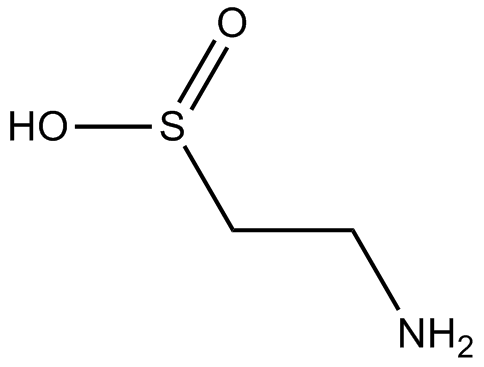Hypotaurine |
| Catalog No.GC14943 |
La hipotaurina (Ácido 2-aminoetanosulfÍnico), un intermediario en la biosÍntesis de taurina a partir de la cisteÍna en los astrocitos, es un aminoÁcido inhibidor endÓgeno del receptor de glicina.
Products are for research use only. Not for human use. We do not sell to patients.

Cas No.: 300-84-5
Sample solution is provided at 25 µL, 10mM.
Hypotaurine (2-aminoethanesulfinic acid), an intermediate in taurine biosynthesis from cysteine in astrocytes, is an endogenous inhibitory amino acid of the glycine receptor.
Hypotaurine and taurine are found to reside within the cytosolic compartment of the cell. The ratio of taurine to hypotaurine is approx 50:1. The cytosolic concentration of taurine is approx. 50 mM. The concentration of hypotaurine decreases by 80% when resting neutrophils are converted into actively respiring cells by exposure to opsonized zymosan[1]. Hypotaurine activates hypoxia signaling through the competitive inhibition of prolyl hydroxylase domain-2. This leads to the activation of hypoxia signaling as well as to the enhancement of glioma cell proliferation and invasion[2].
Hypotaurine has antinociceptive effects on thermal, mechanical, and chemical nociception in the spinal cord. In CCI rats, hypotaurine alleviates mechanical allodynia and thermal hyperalgesia. Intrathecal hypotaurine suppresses acute, inflammatory, and neuropathic pain. Hypotaurine may regulate nociceptive transmission physiologically by activating glycinergic neurons in the spinal cord[3].
References:
[1]. Green TR, et al. Antioxidant role and subcellular location of hypotaurine and taurine in human neutrophils. Biochim Biophys Acta. 1991 Jan 23;1073(1):91-7. https://www.ncbi.nlm.nih.gov/pubmed/1846756
[2]. Gao P, et al. Hypotaurine evokes a malignant phenotype in glioma through aberrant hypoxic signaling. Oncotarget. 2016 Mar 22;7(12):15200-14.
[3]. Hara K, et al. Antinociceptive effect of intrathecal administration of hypotaurine in rat models of inflammatory and neuropathic pain. Amino Acids. 2012 Jul;43(1):397-404. Hara K, et al. Antinociceptive effect of intrathecal administration of hypotaurine in rat models of inflammatory and neuropathic pain. Amino Acids. 2012 Jul;43(1):397-404.
Average Rating: 5 (Based on Reviews and 4 reference(s) in Google Scholar.)
GLPBIO products are for RESEARCH USE ONLY. Please make sure your review or question is research based.
Required fields are marked with *




















